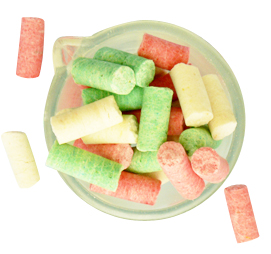
Cereal and Semi-pure Diet Comparison
Diets are formulated to a set nutritional specification from a range of raw materials. Normally the list of ingredients includes grains and grain byproducts, other plant materials, meat, fish, vegetable oils, minerals such as limestone or dolomite and many other “natural” materials. In addition to the well defined nutritional composition, such as amino acid composition or calcium content, “natural” raw materials contain compounds that are physiologically and / or pharmacologically active. The list of these compounds includes:
- Phytosterols known to have activity in many metabolic systems.
- Trace contamination of mycotoxins (not toxic to the animal eating the diet but their presence changes the way an animal metabolises food).
- Accidental inclusions such as herbicides or pesticides. While we carefully select all raw materials to reduce the risk of these type of compounds, we can’t totally ignore their presence. Often they are present at a level less than we can detect. Not being able to detect the compound does not however mean that it is not active in the animal eating the diet.
- Many other compounds, some of which have not yet been “discovered”. The more we study natural feeds and foods the more we find that they are incredibly complex.
While this mixture can make a very good diet for breeding, growth or maintenance, the presence of the trace compounds can create a problem. When researchers are trying to study a particular aspect of physiology, biochemistry or pharmacology the presence of these trace compounds and the variation in natural raw materials can significantly interfere with the findings.
To get around this problem we can formulate diets from highly refined raw materials such as:
- Casein or gelatin or other protein isolates as a source of the essential amino acids.
- Refined glucose, sucrose or starches as metabolisable carbohydrates.
- Refined cellulose as non-metabolisable or difficult to metabolise carbohydrates.
- Refined oils as a source of the essential fats.
- Refined minerals as a source of essential electrolytes and trace minerals.
- High purity vitamins.
With this approach we can make a diet that is highly defined and can be reproduced at any time of year, anywhere. Since we are controlling the diet to such an extent we do have to be very careful that all of the dietary needs are met. For rats and mice semi-pure diets have been in existence for some time. The AIN series of diets were developed exclusively for this use. Over the years the diets have been modified including a greater range of trace compounds. While we may not understand fully how these compounds are important we have good evidence that they are required. For short – mid term trials and some long term trials AIN93G and AIN93M are appropriate. For very long term trials (lifetime studies) a further modification to AIN93 may be required.
The disadvantage of semi-pure diets is in cost. For a similar diet the raw material cost of making a semi-pure diet is 2 – 5 times that based on natural raw materials.
We have several production facilities at Specialty Feeds for making different batch sizes or types of diets.
Cereal based diets can be made in the larger scale plant if the batch size is greater than 500 Kg. This greatly reduces the cost of manufacture, however we believe it is not wise to do this with the semi-pure diets. In a highly defined and controlled diet he risk of contamination is too great in the large scale plant. Hence there are no economies of scale for making batch sizes greater than 100 Kg for the semi-pure diets.